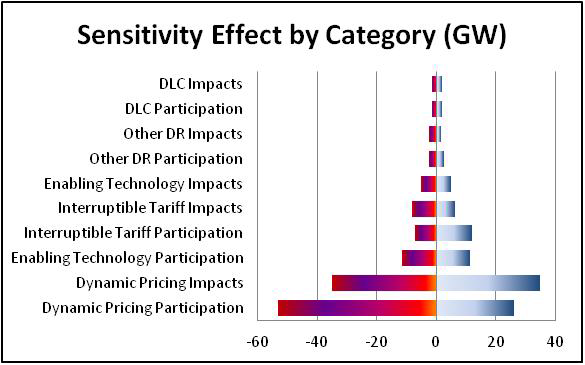The Climate and Energy Policy Laboratory (CEPL) has collaborated with Oak Ridge National Laboratory (ORNL) to produce a report on the potential energy impacts of demand response (DR) in the Eastern Interconnection region (EI). DR is a form of demand-side management executed by utilities with the intention of reducing peak loads. Peak load reductions lead to savings for both customers and utilities through reduced system costs. Because of this potential for system cost savings, the US Department of Energy (DOE) issued a research call bearing a need to “…significantly improve the knowledge base and modeling capabilities for demand-side resources for purposes of transmission planning.” The report describes a study that estimates potential for DR to reduce peak loads until 2030, as well as the associated costs and benefits of reducing peak load.
A key finding of the study was that DR has a strong potential to reduce peak loads in the EI. On average, DR was estimated to reduce peak loads between 6% and 30% throughout US states. Figure 1 below displays the pattern of DR reductions over time resulting from the assumptions in each technology scenario. In the early years, roll-outs of advanced metering infrastructure occur, leading to a rapid decline in peak loads. While the BAU scenario assumes that current levels of AMI deployment continue into the future, the Optimistic, Aggressive, and Full Deployment scenarios assume progressively greater deployments of AMI. The Aggressive and Full Deployment scenarios assume that all ratepayers receive AMI; the Full Deployment scenario goes further than the Aggressive scenario, however, by assuming that all eligible customers are given enabling technologies. Enabling technologies allow for particularly strong effects through dynamic pricing programs.

As can be seen in Figure 2, dynamic pricing programs are a particularly strong driver of overall DR impacts. Figure 2 presents a sensitivity analysis of peak load reductions to various parameters assumed in the technology scenarios. The impacts, i.e. load reductions, from dynamic pricing programs play a large role in determining the overall peak reduction of DR in a given state. The presence of enabling technology not only creates greater impacts from dynamic pricing programs, but also enables greater participation in dynamic pricing programs – driving a primary contributor to overall DR impacts.

The study made use of several technology deployment scenarios to forecast the exten to which DR could penetrate into US electricity markets. Key technologies related to DR were Advanced Metering Infrastructure (AMI), commonly known as “smart metering,” and so-called “enabling technologies’ which allowed customers to respond automatically to high prices during peak hours. The costs of deploying DR were largely driven by these technologies, and ranged from approximately $37 billion in low-deployment scenarios to approximately $75 billion in high-deployment scenarios.
For further information about the DR report, please contact Alexander Smith (asmith313@gatech.edu)
Resources:
